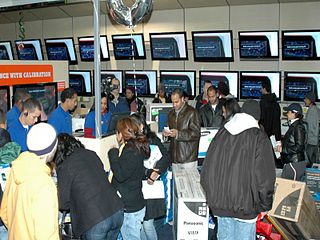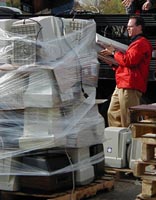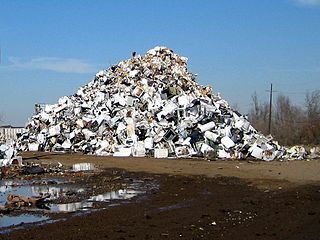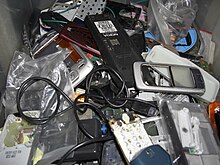
Recycling is the process of converting waste materials into new materials and objects. This concept often includes the recovery of energy from waste materials. The recyclability of a material depends on its ability to reacquire the properties it had in its original state. It is an alternative to "conventional" waste disposal that can save material and help lower greenhouse gas emissions. It can also prevent the waste of potentially useful materials and reduce the consumption of fresh raw materials, reducing energy use, air pollution and water pollution.

Consumer electronics or home electronics are electronic equipment intended for everyday use, typically in private homes. Consumer electronics include devices used for entertainment, communications and recreation. These products are usually referred to as black goods due to many products being housed in black or dark casings. This term is used to distinguish them from "white goods" which are meant for housekeeping tasks, such as washing machines and refrigerators, although nowadays, these would be considered black goods, some of these being connected to the Internet. In British English, they are often called brown goods by producers and sellers. In the 2010s, this distinction is absent in large big box consumer electronics stores, which sell entertainment, communication and home office devices, light fixtures and appliances, including the bathroom type.

Electronic waste recycling, electronics recycling, or e-waste recycling is the disassembly and separation of components and raw materials of waste electronics; when referring to specific types of e-waste, the terms like computer recycling or mobile phone recycling may be used. Like other waste streams, reuse, donation, and repair are common sustainable ways to dispose of IT waste.

Electronic waste describes discarded electrical or electronic devices. It is also commonly known as waste electrical and electronic equipment (WEEE) or end-of-life (EOL) electronics. Used electronics which are destined for refurbishment, reuse, resale, salvage recycling through material recovery, or disposal are also considered e-waste. Informal processing of e-waste in developing countries can lead to adverse human health effects and environmental pollution. The growing consumption of electronic goods due to the Digital Revolution and innovations in science and technology, such as bitcoin, has led to a global e-waste problem and hazard. The rapid exponential increase of e-waste is due to frequent new model releases and unnecessary purchases of electrical and electronic equipment (EEE), short innovation cycles and low recycling rates, and a drop in the average life span of computers.

The electronics industry is the economic sector that produces electronic devices. It emerged in the 20th century and is today one of the largest global industries. Contemporary society uses a vast array of electronic devices that are built in factories operated by the industry, which are almost always partially automated.
There is no national law in the United States that mandates recycling. State and local governments often introduce their own recycling requirements. In 2014, the recycling/composting rate for municipal solid waste in the U.S. was 34.6%. A number of U.S. states, including California, Connecticut, Delaware, Hawaii, Iowa, Maine, Massachusetts, Michigan, New York, Oregon, and Vermont have passed laws that establish deposits or refund values on beverage containers while other jurisdictions rely on recycling goals or landfill bans of recyclable materials.

Waste are unwanted or unusable materials. Waste is any substance discarded after primary use, or is worthless, defective and of no use. A by-product, by contrast is a joint product of relatively minor economic value. A waste product may become a by-product, joint product or resource through an invention that raises a waste product's value above zero.

Computer hardware includes the physical parts of a computer, such as the central processing unit (CPU), random access memory (RAM), motherboard, computer data storage, graphics card, sound card, and computer case. It includes external devices such as a monitor, mouse, keyboard, and speakers.
Guiyu, in Guangdong Province, China, is widely perceived as the largest electronic waste (e-waste) site in the world. In 2005, there were 60,000 e-waste workers in Guiyu who processed the more than 100 truckloads that were transported to the 52-square-kilometre area every day. The constant movement into and processing of e-wastes in the area leading to the harmful and toxic environment and living conditions, coupled with inadequate facilities, have led to the Guiyu town being nicknamed the "electronic graveyard of the world".

Electronic waste or e-waste in the United States refers to electronic products that have reached the end of their operable lives, and the United States is beginning to address its waste problems with regulations at a state and federal level. Used electronics are the quickest-growing source of waste and can have serious health impacts. The United States is the world leader in producing the most e-waste, followed closely by China; both countries domestically recycle and export e-waste. Only recently has the United States begun to make an effort to start regulating where e-waste goes and how it is disposed of. There is also an economic factor that has an effect on where and how e-waste is disposed of. Electronics are the primary users of precious and special metals, retrieving those metals from electronics can be viewed as important as raw metals may become more scarce

CWG, also known as Communications Wireless Group, LLC, is a global repurposing source for the wireless industry that specializes in the recycling and reuse of old cell phones, smartphones and associated accessories.
Electronic waste or e-waste in China refers to electronic products that are no longer usable and are therefore dumped or recycled. China is the world's largest importer and producer of electronic waste with over 70% of all global e-waste ending up in the world's largest dumpsites. An estimated 60–80% of this e-waste is handled through illegal informal recycling processes, without the necessary safety precautions legally required by Chinese government regulations. Processing e-waste in this way directly causes serious environmental damage and permanent health risks in areas surrounding the disposal sites. While the Chinese government and the international community have taken action to regulate e-waste management, ineffective enforcement, legislative loopholes, and the pervasiveness of informal recycling have been obstacles to mitigating the consequences of e-waste.

As a nation, Americans generate more waste than any other nation in the world, officially with 4.4 pounds (2.0 kg) of municipal solid waste (MSW) per person per day, with another study estimating 7.1 pounds (3.2 kg) per capita per day. Fifty five percent of this waste is contributed as residential garbage, while the remaining forty five percent of waste in the U.S.'s 'waste stream' comes from manufacturing, retailing, and commercial trade in the U.S. economy. According to the American Society of Civil Engineers, Nevada produces the most waste at "[nearly] 8 pounds (3.6 kg) per person per day". Approximately 90% of all waste produced by Nevadans ends up in landfills. "Wasteful" states Michigan, New Mexico, Wisconsin and Oregon as well as Washington also dominated the list's 5-year period.
Recommerce or reverse commerce is the selling of previously owned, new or used products, mainly electronic devices or media such as books, through physical or online distribution channels to buyers who repair, if necessary, then reuse, recycle or resell them.

Appliance recycling is the process of dismantling scrapped home appliances to recover their parts or materials for reuse. Recycling appliances for their original or other purposes, involves disassembly, removal of hazardous components and destruction of the equipment to recover materials, generally by shredding, sorting and grading. The rate at which appliances are discarded has increased due in part to obsolescence due to technological advancement, and in part to not being designed to be repairable. The main types of appliances that are recycled are televisions, refrigerators, air conditioners, washing machines, and computers. When appliances are recycled, they can be looked upon as a valuable resources; if disposed of improperly, they can be environmentally harmful and poison ecosystems.
Closing the Loop is a company that offers a closed loop service for mobile phones. The Dutch social enterprise is based in Amsterdam, the Netherlands. It was founded with the aim to reduce electronic waste (e-waste). It does this by offering users and sellers of phones a way to make their device material-neutral and waste free. The company pays people in emerging markets to collect scrap phones. These phones are then recycled for Closing the Loop’s customers. The proposition works on a one for one basis, where a customer’s phone is ‘offset’ by the recycling of a broken phone. Known customers are Shiftphone, T-Mobile, KPMG, the city of Utrecht, Rabobank and the Dutch national government.
Sustainable electronics are electronic products made with no toxic chemicals, recyclable parts, and reduced carbon emissions during production. "Sustainability is still very new, emerging business concept. Because of that, we lack uniform guidelines or standards applicable per industry sector that can help companies establish best practices."

Electronic waste is emerging as a serious public health and environmental issue in India. India is the "Third largest electronic waste producer in the world"; approximately 2 million tons of e-waste are generated annually and an undisclosed amount of e-waste is imported from other countries around the world.
Electrical and electronic equipment (EEE) waste, or e-waste, is illegally brought into African states every year. A minimum of 250,000 metric tons of e-waste comes into the continent, and according to the Swiss Federal Laboratories for Materials Science and Technology, the majority of it in West Africa enters from Europe. Developed countries commodify underdeveloped African states as dumping grounds for their e-waste, and due to poor regulations and a lack of enforcement institutions, illegal dumping is promoted. Currently, the largest e-waste dumping site in Africa is Agbogbloshie in Ghana. While states like Nigeria do not contain e-waste sites as concentrated as Agbogbloshie, they do have several small sites.
The environmental impact of big tech is a phenomenon in which many aspects of Big Tech contribute to negative impacts on the environment and climate change. In the big data age, technologists and people in general find it valuable to view emerging technologies with a critical lens, one of which is geared toward the environment. As these emerging technologies become more popular, they consider the extent at which they contribute to changes in the environment and whether they are inherently positive or negative.













